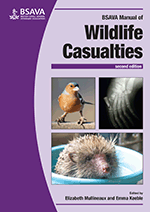
Full text loading...

British marine mammals primarily include cetaceans (whales, dolphins and porpoises) and pinnipeds (seals). It is rare for a veterinary surgeon to be called upon to assist with a cetacean; seals in need of assistance, particularly juveniles, may be reported in coastal areas. A wide range of species and the special considerations required for them are covered in the following areas: ecology and biology; anatomy and physiology; capture, handling and transportation; clinical assessment; first aid and hospitalization; anaesthesia and analgesia; specific conditions; therapeutics; husbandry; rearing of seal pups; rehabilitation and release; and legal considerations.
Marine mammals, Page 1 of 1
< Previous page | Next page > /docserver/preview/fulltext/10.22233/9781910443316/9781910443316.23-1.gif

Full text loading...























